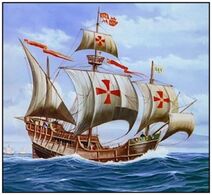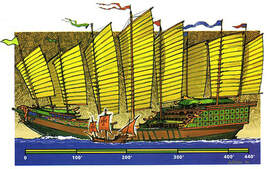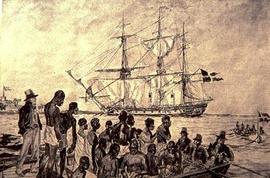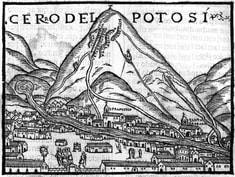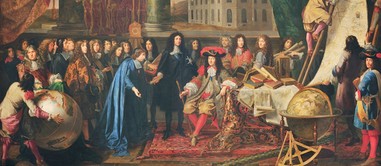Unit Four: The First Global Age (1450 C.E. to 1770 C.E.)
Existing Patterns of Trade
To start this unit we need to review three previous sections as they are key to the changes that will take place during this unit. The three lessons are: The Mediterranean Trade routes lesson. The second is the Indian Ocean Trade Routes lesson which also has an important map of the Indian Ocean Trade Routes to help one understand the trading lanes. The final lessons on this short section covers the Early Civilizations of West Africa lesson.
Existing Patterns of Trade
To start this unit we need to review three previous sections as they are key to the changes that will take place during this unit. The three lessons are: The Mediterranean Trade routes lesson. The second is the Indian Ocean Trade Routes lesson which also has an important map of the Indian Ocean Trade Routes to help one understand the trading lanes. The final lessons on this short section covers the Early Civilizations of West Africa lesson.
The Age of Discovery and Exploration
Prior to the Europeans sailing around the Cape of Good Hope in Africa, there was a great Chinese explorer Zheng He. In additional to this handout are two other documents: A comparison of the master ship of Zheng He to that of Christopher Columbus and then a short video assignment with key questions to answer at the end on the voyages of Zheng He. To better understand the Zheng He assignment, the attached link is a map of the Voyages of Zheng He showing how much area his expeditions covered. The picture below shows a comparison between the master ship of Zheng He's fleet and one of the three ships led by Columbus in his discovery of the New World.
Prior to the Europeans sailing around the Cape of Good Hope in Africa, there was a great Chinese explorer Zheng He. In additional to this handout are two other documents: A comparison of the master ship of Zheng He to that of Christopher Columbus and then a short video assignment with key questions to answer at the end on the voyages of Zheng He. To better understand the Zheng He assignment, the attached link is a map of the Voyages of Zheng He showing how much area his expeditions covered. The picture below shows a comparison between the master ship of Zheng He's fleet and one of the three ships led by Columbus in his discovery of the New World.
European Discovery and Exploration
The Age of Discovery lesson starts the change to Western European dominance of global society and is linked to the following in the Scientific Revolution and the Enlightenment lesson. As a supplement to the above lessons, I have created a European Explorers chart and sometimes, if time allows, I use for my classes, the European Discoverers who changed the world group project instructions. This link shows a completed class project from 2017 on Ten European Explorers.
The Europeans were now able to travel long distances due to the caravel. The following link opens to a cross-section of a caravel that shows how much cargo it could carry along with the advanced technology for sailing around the world.
The New World
Native American history is often overlooked as their image has been portrayed as savages and unimportant. This is not true and many Naïve American societies were highly advanced. The three following documents are key to understanding their side of the story. The first is a First Americans map and the following is a Native American Cultures chart and finally a Native American Cultures map. I have added here a previously shown handout on Mesoamerican empires to identify their locations once Columbus and the Spanish arrive after 1492. A map of the Americas (the New World) can be found at this link to clarify the geography of the region.
The arrival of the Western Europeans totally changed societies in the Americas and a massive cultural change took place. The following documents are excellent proof of the creation of new agricultural, political, social and economic systems brought to the New World. They are the Origin of World Crops handout, the Columbian Exchange chart, an academic article on The Columbian Exchange, and an extract article on Foods that Changed the World.
The need for new forms of human labor changed dramatically with the arrival of the Western Europeans in the Americas and it started in part from the handout the European Treatment of Native Americans. This in turn led to the African diaspora and the need for slaves to work the cash crops of sugarcane, tobacco and later on cotton plantations. This lesson covers an Overview of the Slave Trade.
The Age of Discovery lesson starts the change to Western European dominance of global society and is linked to the following in the Scientific Revolution and the Enlightenment lesson. As a supplement to the above lessons, I have created a European Explorers chart and sometimes, if time allows, I use for my classes, the European Discoverers who changed the world group project instructions. This link shows a completed class project from 2017 on Ten European Explorers.
The Europeans were now able to travel long distances due to the caravel. The following link opens to a cross-section of a caravel that shows how much cargo it could carry along with the advanced technology for sailing around the world.
The New World
Native American history is often overlooked as their image has been portrayed as savages and unimportant. This is not true and many Naïve American societies were highly advanced. The three following documents are key to understanding their side of the story. The first is a First Americans map and the following is a Native American Cultures chart and finally a Native American Cultures map. I have added here a previously shown handout on Mesoamerican empires to identify their locations once Columbus and the Spanish arrive after 1492. A map of the Americas (the New World) can be found at this link to clarify the geography of the region.
The arrival of the Western Europeans totally changed societies in the Americas and a massive cultural change took place. The following documents are excellent proof of the creation of new agricultural, political, social and economic systems brought to the New World. They are the Origin of World Crops handout, the Columbian Exchange chart, an academic article on The Columbian Exchange, and an extract article on Foods that Changed the World.
The need for new forms of human labor changed dramatically with the arrival of the Western Europeans in the Americas and it started in part from the handout the European Treatment of Native Americans. This in turn led to the African diaspora and the need for slaves to work the cash crops of sugarcane, tobacco and later on cotton plantations. This lesson covers an Overview of the Slave Trade.
In North America, the British had a different approach to colonization. It started with the colony in Jamestown and then thousands more, including entire families came to escape religious persecution. The Mayflower Compact extract is a unique document in North American history as it is the first known written agreement on political rule within the colonies. The pilgrims, or the Puritan Migrations to the New World began to change society and hep create the Thirteen Colonies. It is important to know these regions and the attached is a Thirteen Colonies blank map assignment. Colonial life in North America is often a question on examinations and one of the best examples to understand this cultural change is to analyze a typical New England village drawing. To enforce colonial rule, the British created a unique political system and this handout shows How Mercantilism worked, and the illustration in the document shows the European view. A more in-depth document on this is the Mercantilism in North America handout.
Economics played a major role in both North and South America and the following documents create a comparison that is a frequently used short-answer or essay question. The first is a reading assignment with questions based on Potosi and the Spanish labor systems in South America called Silver as a Major Global Commodity. In addition, I have created a special assignment with primary source documents on Potosi and the Global Silver Trade. The last document covers the difference of labor systems in North America and is a presentation on Indentured Servants.
In North America, the British had a different approach to colonization. It started with the colony in Jamestown and then thousands more, including entire families came to escape religious persecution. The Mayflower Compact extract is a unique document in North American history as it is the first known written agreement on political rule within the colonies. The pilgrims, or the Puritan Migrations to the New World began to change society and hep create the Thirteen Colonies. It is important to know these regions and the attached is a Thirteen Colonies blank map assignment. Colonial life in North America is often a question on examinations and one of the best examples to understand this cultural change is to analyze a typical New England village drawing. To enforce colonial rule, the British created a unique political system and this handout shows How Mercantilism worked, and the illustration in the document shows the European view. A more in-depth document on this is the Mercantilism in North America handout.
Economics played a major role in both North and South America and the following documents create a comparison that is a frequently used short-answer or essay question. The first is a reading assignment with questions based on Potosi and the Spanish labor systems in South America called Silver as a Major Global Commodity. In addition, I have created a special assignment with primary source documents on Potosi and the Global Silver Trade. The last document covers the difference of labor systems in North America and is a presentation on Indentured Servants.
Absolutism
To complete this unit, it is important to understand the way European countries were ruled during this time period. The following lessons look at the political structures and systems within the continent as well as the emergence of several strong empires.
In Western Europe, many kings and queens were the ultimate authority for their nations. They were called Absolute Rulers. The best example of a rulers under this system is seen in the handout covering the reign of Louis XIV. Another Western European example is indicated in the handout called Absolutism in England. However, the following document illustrates what happens if a monarch's rule is not what the people want. The English Bill of Rights handout covers this issue and contains key questions to answer.
Two families controlled large amounts of mainland Europe during this time period. They were the Hapsburg (Habsburg) and Hohenzollerns and their histories are recorded in the handout called The Rise of Austria and Prussia.
A very important lesson to fully comprehend is The Rise of Russia. It covers the time periods of 1328 C.E. to 1796 C.E. which are the reigns of Ivan I to Catherine the Great. Both of these lessons are prerequisites for a better understanding of the first section in the 10th grade section as they connect to the era of The Scientific Revolution and the Enlightenment.
Two families controlled large amounts of mainland Europe during this time period. They were the Hapsburg (Habsburg) and Hohenzollerns and their histories are recorded in the handout called The Rise of Austria and Prussia.
A very important lesson to fully comprehend is The Rise of Russia. It covers the time periods of 1328 C.E. to 1796 C.E. which are the reigns of Ivan I to Catherine the Great. Both of these lessons are prerequisites for a better understanding of the first section in the 10th grade section as they connect to the era of The Scientific Revolution and the Enlightenment.
